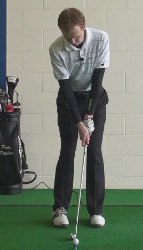
Chipping
When it comes to chipping in golf, striking the ball cleanly and accurately is crucial for successful short game performance. Here are some key tips and techniques for improving your chipping strike:
- Ball Position: Proper ball position is essential for a solid chipping strike. Generally, you'll want to position the ball slightly back in your stance, around the center or slightly back of center. This helps ensure a downward strike and clean contact with the ball.
- Weight Distribution: As you set up for a chip shot, shift your weight slightly onto your front foot. This helps promote a descending strike and prevents the club from digging too much into the ground behind the ball.
- Hands Ahead of the Ball: To encourage a crisp strike, position your hands slightly ahead of the ball at address and maintain this position throughout the chipping motion. This helps ensure a downward strike and a clean, ball-first contact.
- Short, Controlled Backswing: Keep your chipping backswing relatively short and controlled. Focus on using your wrists and arms rather than making a big, full swing. This allows for better control and consistency in your chipping strike.
- Maintain a Relaxed Grip: It's important to maintain a light and relaxed grip on the club when chipping. A tight grip can restrict the natural movement of the club and hinder a clean strike. Keep your hands and wrists loose to promote a smooth, crisp strike on the ball.
- Keep Your Eyes on the Ball: Maintain your focus on the ball throughout the chipping motion. This helps ensure clean contact and improves your ability to strike the ball precisely.
- Practice Distance Control: Chipping is not just about striking the ball cleanly but also about controlling the distance. Spend time practicing different chipping distances and focus on developing a consistent strike to control the rollout of the ball after impact.
- Use Proper Club Selection: Choose the appropriate club for the distance and trajectory required for the chip shot. Typically, a pitching wedge, gap wedge, or sand wedge is used for chipping, but the choice of club depends on the specific situation and the desired trajectory.
- Practice and Experiment: Chipping is a skill that requires practice and experimentation. Spend time on the practice green working on your chipping technique, varying the lies and distances to simulate real on-course scenarios. Experiment with different techniques, grips, and club selections to find what works best for you.
- Seek Professional Guidance: Working with a golf instructor can greatly benefit your chipping strike. A qualified instructor can assess your technique, provide personalized feedback, and offer drills and practice routines to improve your chipping skills.
Remember, consistent practice and patience are key to improving your chipping strike. By focusing on technique, maintaining a relaxed grip, and practicing regularly, you can develop a solid and reliable chipping game to lower your scores on the golf course.





